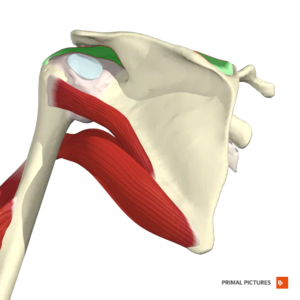External Rotation Lag Sign (ERLS) Test
Original Editor - User Name
Top Contributors - Alan Jit Ho Mak, Amanda Ager, Kim Jackson, Anas Mohamed and Jonathan Wong
Purpose[edit | edit source]
To assess the integrity and tears of the supraspinatus (SSP) and infraspinatus muscle (part of the rotator cuff). Also tests for shoulder impingement. It is also known as the infraspinatus spring back test that also assess for pain, weakness and integrity in the infraspinatus and SSP.
Description[edit | edit source]
A cohort study has concluded that the Lag Sign has a sensitivity of 97% and a specificity of 93% for full thickness tails of the infraspinatus and a sensitivity of 100% and a specificity of 93% for full thickness tears of the teres minor.[1]
1. The patient is seated and the elbow is passively flexed to 90 degrees while the shoulder is held at 20 degrees elevation in the scapular plane in a position of near maximum external rotation (i.e., maximum external rotation minus five degrees to avoid elastic recoil). If your patient is able to hold this position this indicates a negative test for a positive test however, your patient would not be able to hold this position and his arm with spring back anteriorly, indicating that the teres minor and the infraspinatus are weak or painful.
2. The examiner supports the elbow and holds the arm in external rotation at the wrist.
3. The patient is asked to hold the position while the examiner supports the elbow but releases the hold at the wrist.
4. The degree of movement is estivated and is referred to as the “lag” (i.e., the difference between active and passive ROM).
Technique Criticism[edit | edit source]
The external rotation lag sign (ERLS), described by Hertel et al[2] in 1996, has been widely accepted as a valid test for the diagnosis of tears involving at least the infraspinatus. More recently, the test has been re-evaluated. In a population with a low pretest probability for supraspinatus tears, the test has been confirmed to be both highly specific and moderately sensitive for an isolated supraspinatus tear when the surgeon looks for small degrees of lag.
Some concerns are still present regarding the use of the ERLS in the diagnosis of an isolated supraspinatus tear. The reasons for the skepticism could be found in the relative absence of laboratory data and clinical study to support the use of the ERLS. This maybe use to the difficulty in reproducing the ERLS in vitro.[3]
In a study where 40 participants with rotator cuff pathology, they concluded that ERLS will be negative in patients with hypertrophy of teres minor in the setting of posterosuperior cuff tear. Hence, there is a strong correlation cuff tears and hypertrophy of Trees Major muscle, which helps in better prognosis and functional outcome of the patients treated with surgical intervention.[4] Another study has also concluded that the ERLS is potentially able to detect an isolated SSP tear if the test is performed correctly (20 degrees of abduction). The deltoid and biceps muscles are almost silent during the test, limiting confounding factors.
Resources[edit | edit source]
References[edit | edit source]
- ↑ Castoldi F, Blonna D, Hertel R. External rotation lag sign revisited: accuracy for diagnosis of full thickness supraspinatus tear. Journal of Shoulder and Elbow Surgery. 2009 Jul 1;18(4):529-34.
- ↑ Hertel R, Ballmer FT, Lambert SM, Gerber CH. Lag signs in the diagnosis of rotator cuff rupture. Journal of Shoulder and Elbow Surgery. 1996 Jul 1;5(4):307-13.
- ↑ Blonna D, Cecchetti S, Tellini A, Bonasia DE, Rossi R, Southgate R, Castoldi F. Contribution of the supraspinatus to the external rotator lag sign: kinematic and electromyographic pattern in an in vivo model. Journal of shoulder and elbow surgery. 2010 Apr 1;19(3):392-8.
- ↑ Vella S, Rao AS. Relation between hypertrophy of teres minor muscle and external rotation lag sign in patients with rotator cuff pathology. Indian journal of orthopaedics. 2019 Jun;53:392-5.
- ↑ External Rotation Lag Sign Available from:https://www.youtube.com/watch?v=AzDQ9s3qipg [last accessed 23/11/2020]







